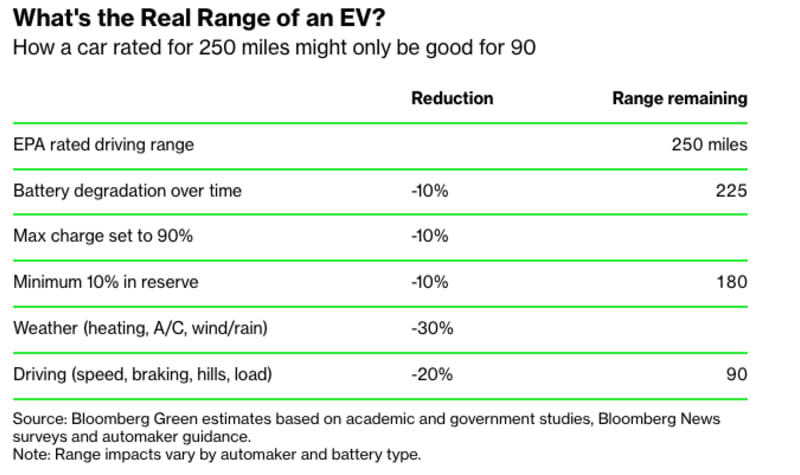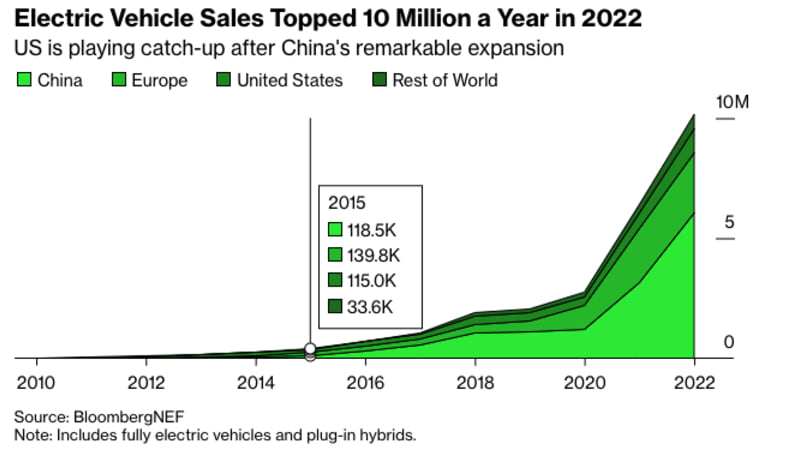Americans insist on 300 miles of EV range. They’re right

Americans love a good road trip. There’s nothing better than packing up your stuff, turning up the music, and just — driving. For more than a century, summertime dreams have been fueled by the limitless possibilities of a full tank of gas.
That same “live free or die” mentality has also made the U.S., until recently, slower to adopt electric cars. The open road is freedom, and the need to frequently stop and charge an intrusion. Last year, plug-in vehicles made up less than 8% of new-car sales in the US — far behind Europe’s 32% EV adoption rate and China’s 30% uptake.
These places got a head start in part by embracing tiny EVs with small batteries and limited range. By contrast, a survey conducted last year by Bloomberg Green found that fewer than 10% of U.S. respondents would settle for anything less than 200 miles of range. More recent number-crunching on ranges for EVs sold in the U.S. found that:
Americans are demanding the longest ranges in the world, roughly a third more than the global average.
The average EV range is on the cusp of exceeding 300 miles, a key psychological barrier.
Many have been quick to wag their fingers at this quintessential American excess. The average U.S. commute is 55 miles a day, the thinking goes, so why the need for so many more miles? But America’s EV exceptionalism reflects a more nuanced understanding of range limitations than consumers are typically given credit for.
What affects EV range? A lot
Americans spend more time in their cars than drivers in any other country. U.S. road travel totals about 4 trillion miles a year, or roughly 14,500 miles per person — a third more than any other country. That makes range anxiety particularly acute for Americans, whose access to charging networks is still limited. For new EV buyers, figuring out how much range is really needed can be complicated.
The problem is that a car rated for 250 miles of range doesn’t actually provide 250 miles of reliable range. The number drops when you turn on the heater or air conditioning, or drive in the rain or against a strong wind. Sudden stops and frequent braking also eat up mileage. So does driving over 60 miles per hour, loading the car with passengers and luggage, or using a ski or bike rack.
Even under perfect conditions, drivers can’t count on all of those rated miles. Just like with a gasoline tank, running a battery down to empty risks leaving you stranded, so it’s important to hold some miles in reserve. Most batteries also aren’t meant to be charged to the max — Tesla, for example, recommends topping off at no more than 90% for daily charging. Finally, car buyers who plan to hold onto their vehicle for many years will have to anticipate battery degradation over time, which is accelerated for smaller batteries.
All of these factors together can easily reduce the usable range on a 250-mile battery down to 90 miles.
On its face, 90 miles seems like it should be plenty to cover the average day for most drivers. But plenty of days aren’t average: the times you forget to plug your car in at night, or lose power, or unexpectedly need to run extra errands or check in with a friend on the other side of town.
Well, one might ask, isn’t that what public chargers are for?
A little quirk of EV charging is that it’s typically much faster to add a few miles of charge to a big battery than to a smaller one. That’s because longer-range batteries are made with materials better suited to fast charging. Also, once a battery is half full, the charging rate begins to slow, so smaller batteries spend less time adding miles at their maximum charge rate.
What this all means is that 10 minutes at a highway charger might add 160 miles of driving to a long-range Kia EV6, but just 32 miles to a base Nissan Leaf. Drivers have to plan their pit stops accordingly.
Experienced EV owners learn how to extend the range on long drives — by keeping their coats zipped and their heaters on low while driving in cold weather, for example, or slowing to 60 miles per hour on the highway instead of 75 when stretching to make it to the next charge. But mass adoption of long-range EVs requires fewer of these compromises.
The technological case for range
Some argue that, given the world’s stretched battery supply, carmakers should prioritize smaller EVs or plug-in hybrids. The rationale is that we should dole out what we’ve got to the largest number of vehicles possible.
But this battery-maximizing strategy rests on the myth that supplies can’t grow any faster, a notion debunked by a century of mass manufacturing. Sure, it usually takes 2 to 3 years for a new battery plant to hit its stride — and up to a decade to plan and develop new mines for essential minerals like lithium and nickel. But when demand is high enough, capitalism finds a way, and profits from batteries in 2023 are just too massive to keep progressing at a 2013 pace.

Right now, miners and refiners of key battery minerals are boosting capacity at their existing plants and opening new operations worldwide at the fastest rate in history. In the U.S. alone, more than $58 billion was invested in the battery supply chain in the eight months through March. The battery supply chain is expanding like a tidal wave, triggered by an earthquake of demand.
Another way battery supplies are growing is with range-expanding battery chemistries that increase output using the same amount of key materials. For instance, a new generation of battery suppliers are adding increasing amounts of silicon to the anode, which is the part of the battery responsible for storing lithium electrons after a charge. This simple tweak can instantly boost range by 20%.
That means the same Panasonic or LG Chem factory that was designed to build enough battery cells for 100,000 cars might suddenly accommodate 120,000 — with no major changes to the factory itself or the critical minerals it uses. These high-silicon anodes will make their debut in luxury long-range vehicles, like the 2025 Mercedes G-Wagon, but they should eventually increase vehicle range and reduce costs across the entire industry.
This pattern is typical of successful technologies, from cell phones to solar panels. Innovation starts in high-end markets, and over time economies of scale bring it to the masses. In this way, U.S. range enthusiasts can be a driving force in reducing battery costs globally.
The environmental case for range
Another argument against big batteries is that they add to the significant environmental cost of EV manufacturing. Giant EVs like the 400-mile-range Chevy Silverado pickup coming later this year have roughly the same lifetime environmental footprint as a gasoline-powered Honda Civic, according to EV researchers at the Massachusetts Institute of Technology. In other words: If everyone trades in their small internal combustion engines for giant EVs, we won’t be making much environmental progress.

But few consumers are trading in Civics for Silverados, or Volkswagen Jettas for Ford F-150 Lightnings. If America’s suburban cowboys can’t be convinced to give up their pickups, they might as well take the combustion engines out of them. Look across any Walmart parking lot in America and imagine if every giant SUV and truck were replaced with a fuel-efficient Toyota Corolla. That’s the scale of environmental achievement inherent to long-range EVs. And the environmental savings will only increase as batteries get more efficient and more of the grid runs on renewable energy sources.
Another thing to consider is the wonder of battery recycling. Although recycling efforts for lithium-ion batteries are still in their infancy, that’s only because few electric cars have reached the end of their usable life. Recycling EV batteries is profitable business, and roughly 95% of the critical minerals can be recovered. Anyone who buys an EV today can expect that most of their battery will be made from newly mined materials at a not-insignificant environmental cost. But anyone who buys an EV today can also expect those materials to be eventually recycled into someone else’s EV.
Better off walking
To be clear: There are plenty of Americans for whom smaller cars, and smaller batteries, are sublime. Those vehicles can be perfect for short city commutes in temperate California, for example. Also, more people should absolutely be riding bikes, walking and using public transportation. If American cities did more to accommodate these things, we’d all be healthier and happier for it.
But walkable cities are not what the average freedom-loving American is thinking about when in the market for a new electric car. The top concern for most consumers is how much range is needed to accommodate their lifestyle — and how much they can afford.
To that end, the big-battery boom is working: As the U.S. approaches its 300-mile range standard, EV adoption is starting to climb faster than in other large markets (boosted in part by subsidies in the Inflation Reduction Act). This year, sales are set to increase by 73%, according to the latest estimate by BloombergNEF. That growth rate is more than twice as fast as China and more than four times faster than Europe.
Consumers aren’t dumb. It isn’t ignorance about how much we drive that’s preventing Americans from choosing lower-range cars. In fact, it’s knowledge about how deeply reliant we’ve become on our vehicles that pushes Americans to demand so much range.
Related video:







